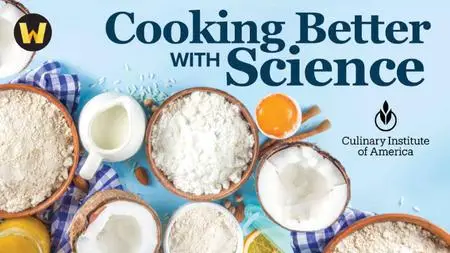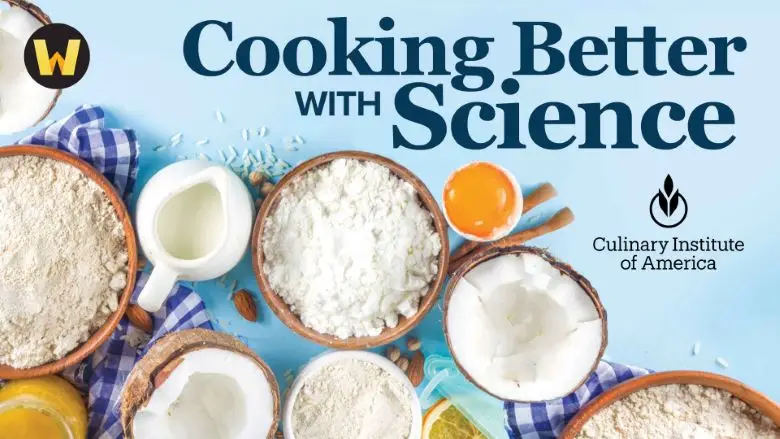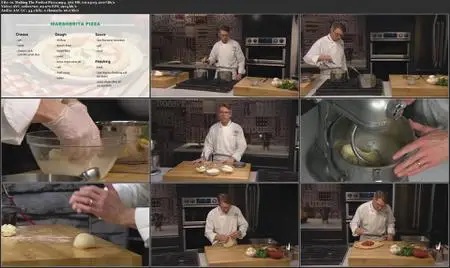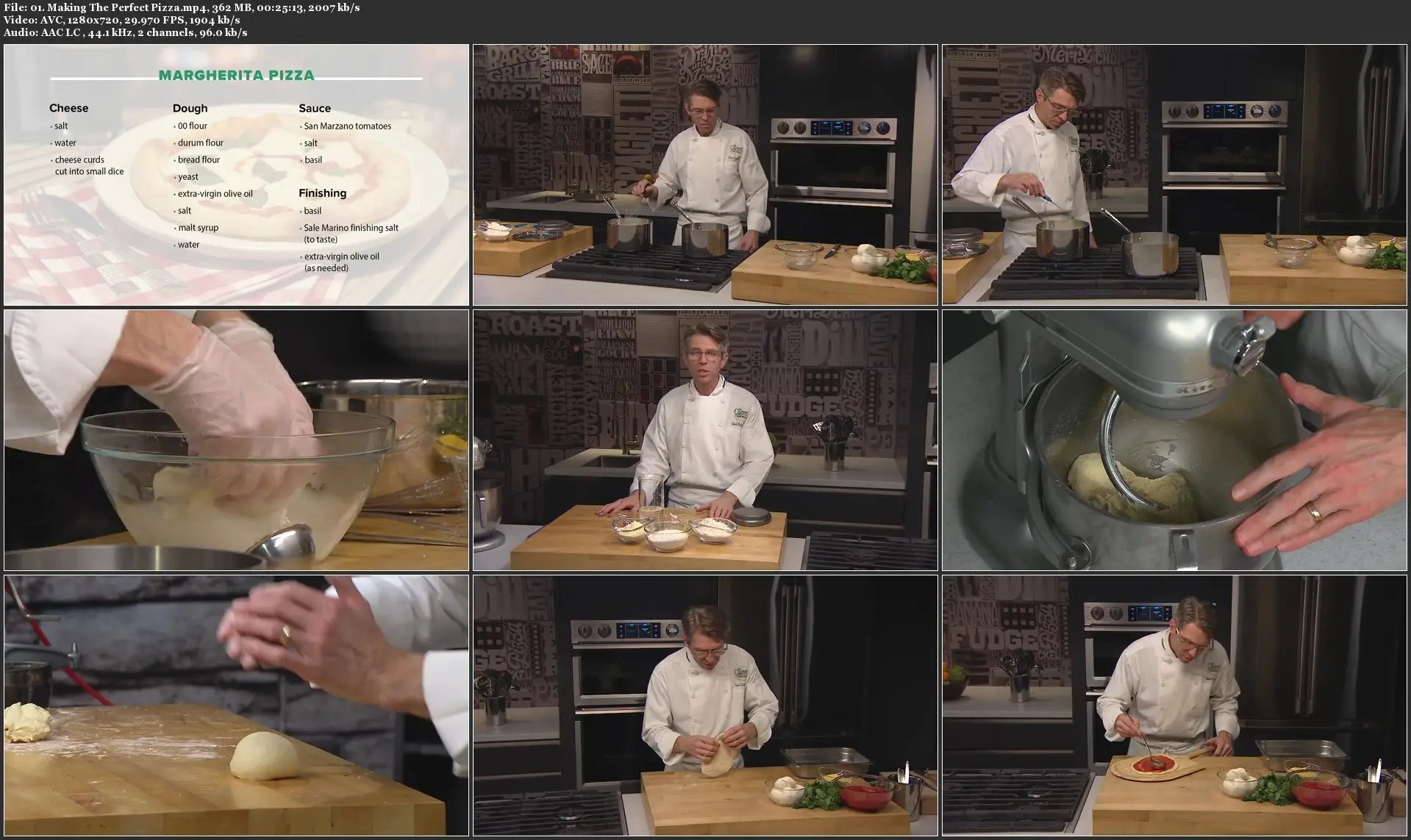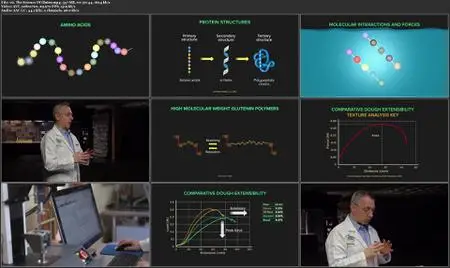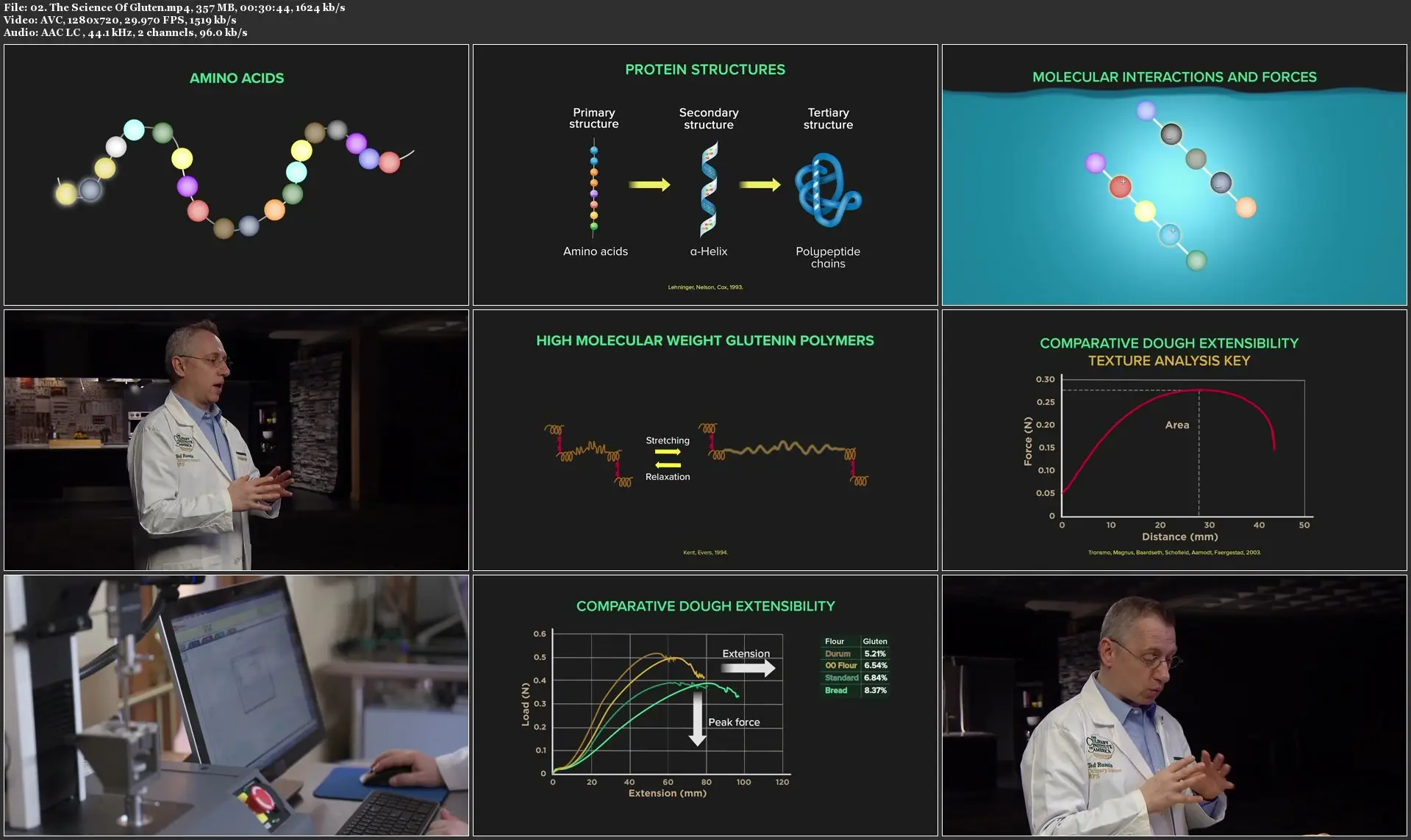TTC Video - Cooking Better with Science
.MP4, AVC, 1280x720, 30 fps | English, AAC, 2 Ch | 5h 57m | 4.52 GB
Lecturers: Sean Kahlenberg, Ted Russin | Course No. 80580
.MP4, AVC, 1280x720, 30 fps | English, AAC, 2 Ch | 5h 57m | 4.52 GB
Lecturers: Sean Kahlenberg, Ted Russin | Course No. 80580
Cooking: Is it art or is it science? As the great culinary chefs worldwide tell their students, it is both.
We all know people who seem to have been born with unique culinary talent—they never use recipes and rarely employ measuring spoons but seem instead to have a preternatural understanding of flavor, texture, and aroma. These artists turn a bare pantry and a few leftovers into a meal beyond imagining; and although you were standing there the entire time, you still are not entirely sure how they did it.
Now, you can also master the skills of great chefs. With science and practice, you can become a culinary magician, astonishing your friends and family with your newfound knowledge and skill, creating dishes that nourish the body and feed the soul.
Enter the secret world of great culinarians with two experts, Sean Kahlenberg, Assistant Professor of Culinary Arts at The Culinary Institute of America (CIA) in Hyde Park, New York, and Ted Russin, Acting Dean of the CIA’s School of Culinary Science and Nutrition. In Cooking Better with Science, their joint expertise will guide you through the world of leveraging science to cook with greater finesse.
The Science of Pizza
Start by following your expert chef into the kitchen to make what seems like a very simple and ordinary dish: pizza. Deceptively simple in practice, making pizza involves complicated and fascinating science. Garnished with the colors of the Italian flag, the pizza Napoletana is the most quintessential of pizzas. According to legend, it was created for Queen Margherita of Savoy during her visit to Naples in 1889, and little has changed about this perfect pizza since. Topped only with simple tomato sauce, fresh mozzarella, and basil leaves, it has captured hearts and imaginations across Italy and around the world for generations.
With Chef Kahlenberg’s savvy instruction, you will see how easy it is to turn fresh milk into curds that are heated and stretched to make mild, smooth, fresh mozzarella. Combined with basil and a simple, homemade pizza sauce, you have the perfect pizza toppings. Learn how Chef Kahlenberg makes pizza dough and explore the different ways you might make your own. Through step-by-step instructions, you’ll see that it’s easier and less time-consuming than you might think, and so, so delicious.
After making your pizza with Chef Kahlenberg, turn to the CIA’s culinary laboratory where Dean Russin works his own magic. With a brief background lesson on proteins and covalent bonds, Dean Russin takes us through the paces in his lab to explore the science of stretch. Using a texture analyzer, discover how a culinary scientist performs an extensibility test, then learn a low-tech version that you can do right in your kitchen at home. You can choose just the right combination to create your ideal pizza dough through careful analysis of flour, sheer force, time, and consequent extensibility.
Most pizza dough requires the help of gluten and yeast to rise to chewy perfection, and we’ll return to the lab to consider these critical components of pizza dough. While the gluten in dough determines the physical properties that allow dough to stretch as we mix, it is yeast that provides leavening and flavor. This single-celled fungus, usually Saccharomyces cerevisiae, or brewer’s yeast, acts through time and fermentation for bold flavor profiles and thick, chewy crusts. You’ll learn the correlation between time and flavor to see why some restaurants keep their pizza dough in a cooler for up to five days before baking.
With the science of both gluten and yeast in mind, you can begin to experiment with your own dough, creating pizzas with bold flavors, textures, and aromas. As a bonus, your expanding understanding of gluten and yeast will inform your other baking, including a wide range of bread, from whole-wheat loaves to perfect naan.
A Perfect Chicken Dinner
What can I make tonight? Is there something easy, delicious, and savory that my family will love, but that is still great for guests and special events? Yes! Roasted chicken always rises to the occasion. Elegant enough for company, but inexpensive enough for every day, the humble chicken seems to do it all—if you know how it’s done. Chef Kahlenberg takes you to the kitchen to share the secrets of restaurant chicken. Learn to prepare your bird, from tying and seasoning to carving and serving. Discover what restaurants do to ensure that chicken is moist and evenly roasted; what sides pair well with chicken; and how to prepare those sides from scratch, including carrot purée, broccoli, pan gravy, and sherry gastrique.
Once you understand how to create an unparalleled chicken dinner, turn your attention to the science that underlies the magic. How do we transform cold, raw chicken into a culinary delight of golden-brown skin and warm, juicy meat, bursting with flavor and aroma? Heat, enzymes, proteins, coenzymes, glycogen, anaerobic respiration, and resulting acid—learn the metabolic processes from the muscle contraction of freshly butchered meat to its final transformation into perfectly cooked food on the table.
Learn all about the Maillard reaction, an essential reaction between proteins and sugars responsible for flavorful browning. Soon, you’ll identify it everywhere: on the crust of bread fresh from your oven; on the surface of seared meat; and that crispy, browned chicken skin on your dinner table. Follow along as Dean Russin describes how Maillard browning works together with the proteins in flour to develop a flavor roux for your pan gravy, an insight into one of the most fundamental reactions in cooking.
Paella Mixta
Originally cooked and served in a wide, shallow pan called a paella, this essential dish of Spain traces its roots to the Spanish city of Valencia on the Mediterranean coast. The mixta, or mixed paella, combines short-grain rice, meat, seafood, sausage, and vegetables and is colored by vibrant yellow saffron. This is Spanish comfort food at its best. Let Chef Kahlenberg show you the essentials of paella: a base of slow-cooked vegetable sofrito, short-grain rice cooked into a “pie” in flavorful broth, seared meat, and vegetables lightly cooked to retain their color and texture. You will even learn the best way to cut an artichoke! Season your paella with a little salt and pepper, and garnish with chopped parsley. Call your family to the table and serve dinner straight from the pan, with a slice of lemon. Let this home-cooked fare bring you together, a fast favorite in every family.
When you have finished your meal and cleaned up (just one pan!), return to the lab to learn more about starch and vegetables, two critical components of paella. First, Dean Russin explores rice, the ideal vehicle for the carbohydrates that densely organize within each grain. Consider various rice types’ different processing and cooking methods and study each variety’s sensory and nutritional attributes. Finally, explore heat and time in relation to vegetable moisture and consequent texture. You will learn how vegetables store water, how heat levels affect that storage, and the texture and flavor outcomes from different cooking techniques. Reflect on this new-found knowledge to better understand the method and ingredients in your paella mixta.
Eggs Three Ways
Not all eggs are created equal, nor are all egg dishes. The three recipes presented merge styles from around the world, but also challenge your knowledge about egg cooking—as well as your understanding of chemistry and cookery! Eggs are simple, but their presence in cooking is pervasive and vital. Join Chef Kahlenberg in the kitchen to learn how to prepare a divine and rustic tortilla española, a light and savory Gruyère and Parmesan cheese soufflé, and a world-class salmon benedict with creamy béarnaise sauce. Whether served for brunch, dinner, or anything in between, all three recipes are sure to please the most discerning palates. If you once considered yourself more an aficionado of food rather than an artist of cuisine, these three dishes represent a graduation into the culinary majors.
Most store-bought eggs appear uniform in size and shape. This appearance is deceptive. Different eggs, often of different ages, possess a pH ranging from seven for the newly laid to nine or even nine and a half in eggs that are a few weeks old. Return to the lab to witness experiments that will expand your understanding of egg texture and viscosity and how they are affected both by the pH of the egg and the presence of potatoes and oil in our tortilla española.
Texturally, a béarnaise sauce and a soufflé could not be more different. Incredibly, they are both made of eggs. In our final episode, learn that the integration of either lipids, in the case of the béarnaise, or air, for the soufflé, determines their structure. Keep your soufflé from collapsing and your béarnaise sauce from breaking by getting a deeper understanding of the nature of eggs.
Bring Your Expertise Home
Whether this is your first cooking course or your one hundred and first, you will be charmed and inspired by the deft instruction of our culinary experts. These lessons provide new and intriguing opportunities for cooks to grow across the spectrum of skill and interest. Join Chef Kahlenberg and Dean Russin as they introduce you to delicious recipes and the science that makes the recipes possible.
Enter the secret world of great culinarians with two experts, Sean Kahlenberg, Assistant Professor of Culinary Arts at The Culinary Institute of America (CIA) in Hyde Park, New York, and Ted Russin, Acting Dean of the CIA’s School of Culinary Science and Nutrition. In Cooking Better with Science, their joint expertise will guide you through the world of leveraging science to cook with greater finesse.
The Science of Pizza
Start by following your expert chef into the kitchen to make what seems like a very simple and ordinary dish: pizza. Deceptively simple in practice, making pizza involves complicated and fascinating science. Garnished with the colors of the Italian flag, the pizza Napoletana is the most quintessential of pizzas. According to legend, it was created for Queen Margherita of Savoy during her visit to Naples in 1889, and little has changed about this perfect pizza since. Topped only with simple tomato sauce, fresh mozzarella, and basil leaves, it has captured hearts and imaginations across Italy and around the world for generations.
With Chef Kahlenberg’s savvy instruction, you will see how easy it is to turn fresh milk into curds that are heated and stretched to make mild, smooth, fresh mozzarella. Combined with basil and a simple, homemade pizza sauce, you have the perfect pizza toppings. Learn how Chef Kahlenberg makes pizza dough and explore the different ways you might make your own. Through step-by-step instructions, you’ll see that it’s easier and less time-consuming than you might think, and so, so delicious.
After making your pizza with Chef Kahlenberg, turn to the CIA’s culinary laboratory where Dean Russin works his own magic. With a brief background lesson on proteins and covalent bonds, Dean Russin takes us through the paces in his lab to explore the science of stretch. Using a texture analyzer, discover how a culinary scientist performs an extensibility test, then learn a low-tech version that you can do right in your kitchen at home. You can choose just the right combination to create your ideal pizza dough through careful analysis of flour, sheer force, time, and consequent extensibility.
Most pizza dough requires the help of gluten and yeast to rise to chewy perfection, and we’ll return to the lab to consider these critical components of pizza dough. While the gluten in dough determines the physical properties that allow dough to stretch as we mix, it is yeast that provides leavening and flavor. This single-celled fungus, usually Saccharomyces cerevisiae, or brewer’s yeast, acts through time and fermentation for bold flavor profiles and thick, chewy crusts. You’ll learn the correlation between time and flavor to see why some restaurants keep their pizza dough in a cooler for up to five days before baking.
With the science of both gluten and yeast in mind, you can begin to experiment with your own dough, creating pizzas with bold flavors, textures, and aromas. As a bonus, your expanding understanding of gluten and yeast will inform your other baking, including a wide range of bread, from whole-wheat loaves to perfect naan.
A Perfect Chicken Dinner
What can I make tonight? Is there something easy, delicious, and savory that my family will love, but that is still great for guests and special events? Yes! Roasted chicken always rises to the occasion. Elegant enough for company, but inexpensive enough for every day, the humble chicken seems to do it all—if you know how it’s done. Chef Kahlenberg takes you to the kitchen to share the secrets of restaurant chicken. Learn to prepare your bird, from tying and seasoning to carving and serving. Discover what restaurants do to ensure that chicken is moist and evenly roasted; what sides pair well with chicken; and how to prepare those sides from scratch, including carrot purée, broccoli, pan gravy, and sherry gastrique.
Once you understand how to create an unparalleled chicken dinner, turn your attention to the science that underlies the magic. How do we transform cold, raw chicken into a culinary delight of golden-brown skin and warm, juicy meat, bursting with flavor and aroma? Heat, enzymes, proteins, coenzymes, glycogen, anaerobic respiration, and resulting acid—learn the metabolic processes from the muscle contraction of freshly butchered meat to its final transformation into perfectly cooked food on the table.
Learn all about the Maillard reaction, an essential reaction between proteins and sugars responsible for flavorful browning. Soon, you’ll identify it everywhere: on the crust of bread fresh from your oven; on the surface of seared meat; and that crispy, browned chicken skin on your dinner table. Follow along as Dean Russin describes how Maillard browning works together with the proteins in flour to develop a flavor roux for your pan gravy, an insight into one of the most fundamental reactions in cooking.
Paella Mixta
Originally cooked and served in a wide, shallow pan called a paella, this essential dish of Spain traces its roots to the Spanish city of Valencia on the Mediterranean coast. The mixta, or mixed paella, combines short-grain rice, meat, seafood, sausage, and vegetables and is colored by vibrant yellow saffron. This is Spanish comfort food at its best. Let Chef Kahlenberg show you the essentials of paella: a base of slow-cooked vegetable sofrito, short-grain rice cooked into a “pie” in flavorful broth, seared meat, and vegetables lightly cooked to retain their color and texture. You will even learn the best way to cut an artichoke! Season your paella with a little salt and pepper, and garnish with chopped parsley. Call your family to the table and serve dinner straight from the pan, with a slice of lemon. Let this home-cooked fare bring you together, a fast favorite in every family.
When you have finished your meal and cleaned up (just one pan!), return to the lab to learn more about starch and vegetables, two critical components of paella. First, Dean Russin explores rice, the ideal vehicle for the carbohydrates that densely organize within each grain. Consider various rice types’ different processing and cooking methods and study each variety’s sensory and nutritional attributes. Finally, explore heat and time in relation to vegetable moisture and consequent texture. You will learn how vegetables store water, how heat levels affect that storage, and the texture and flavor outcomes from different cooking techniques. Reflect on this new-found knowledge to better understand the method and ingredients in your paella mixta.
Eggs Three Ways
Not all eggs are created equal, nor are all egg dishes. The three recipes presented merge styles from around the world, but also challenge your knowledge about egg cooking—as well as your understanding of chemistry and cookery! Eggs are simple, but their presence in cooking is pervasive and vital. Join Chef Kahlenberg in the kitchen to learn how to prepare a divine and rustic tortilla española, a light and savory Gruyère and Parmesan cheese soufflé, and a world-class salmon benedict with creamy béarnaise sauce. Whether served for brunch, dinner, or anything in between, all three recipes are sure to please the most discerning palates. If you once considered yourself more an aficionado of food rather than an artist of cuisine, these three dishes represent a graduation into the culinary majors.
Most store-bought eggs appear uniform in size and shape. This appearance is deceptive. Different eggs, often of different ages, possess a pH ranging from seven for the newly laid to nine or even nine and a half in eggs that are a few weeks old. Return to the lab to witness experiments that will expand your understanding of egg texture and viscosity and how they are affected both by the pH of the egg and the presence of potatoes and oil in our tortilla española.
Texturally, a béarnaise sauce and a soufflé could not be more different. Incredibly, they are both made of eggs. In our final episode, learn that the integration of either lipids, in the case of the béarnaise, or air, for the soufflé, determines their structure. Keep your soufflé from collapsing and your béarnaise sauce from breaking by getting a deeper understanding of the nature of eggs.
Bring Your Expertise Home
Whether this is your first cooking course or your one hundred and first, you will be charmed and inspired by the deft instruction of our culinary experts. These lessons provide new and intriguing opportunities for cooks to grow across the spectrum of skill and interest. Join Chef Kahlenberg and Dean Russin as they introduce you to delicious recipes and the science that makes the recipes possible.


